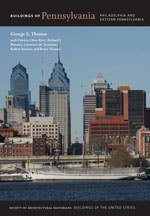
H. Lewis Duhring, a veteran of Frank Furness's office, headed the third firm that gave Chestnut Hill its distinct early-twentieth-century flavor. These might be thought of as “trainer” houses for the young families who would move into the larger houses west of Germantown Avenue. Duhring's work with George Woodward produced some of the most original domestic architecture of the period, including the development of quadruple houses on Benezet Street that share side and rear party walls for low-income housing, anticipating by a generation Frank Lloyd Wright's Suntop houses ( MO5) in Ardmore. Devised to resolve what Woodward euphemistically called the “backyard problem” that occurred when nonelites used their rear yards as ash pits, Woodward's team resolved the difficulty by simply eliminating backyards. The first (1910) of Woodward's reform projects stands across Winston Road at 24–26 and 30–32 Benezet Street. Duhring also designed the curving stone facades of Half Moon court in 1912 at Lincoln Drive and W. Willow Grove Avenue, and in 1913, modified into a studio and residence the late-nineteenth-century ice house at 7900–7906 Lincoln Drive, where ice cut from ponds along the route of Lincoln Drive was stored.

